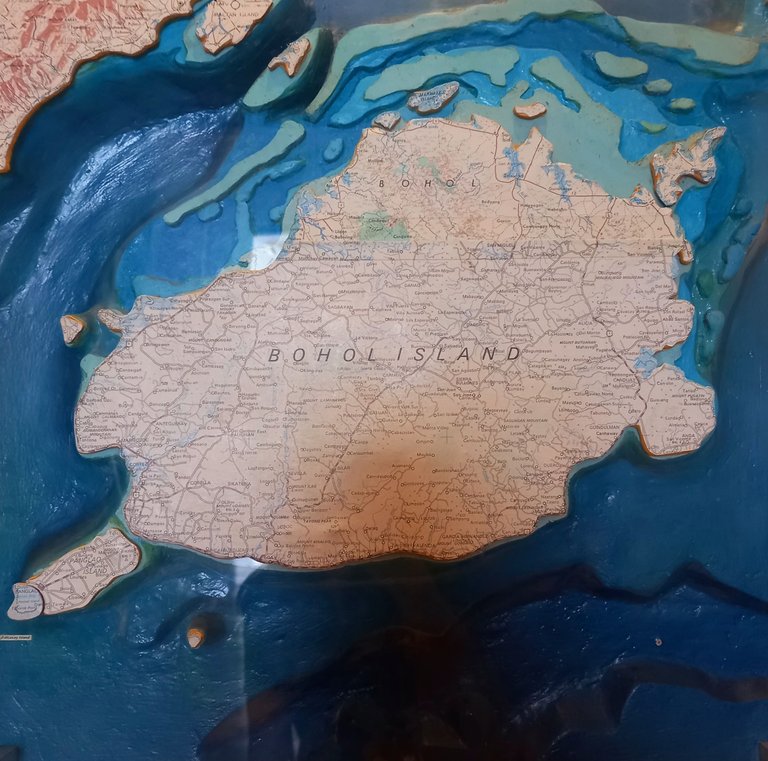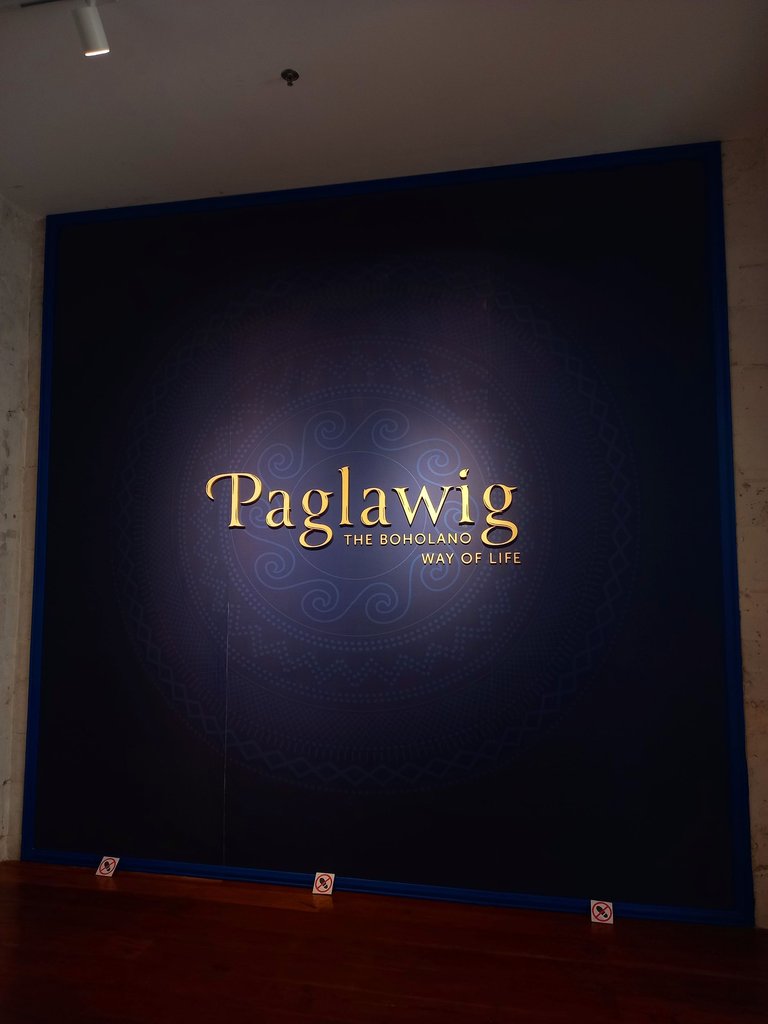Happy Monday Hivers!
Really? That was my reply when the security guard told me that there was no entrance fee at Bohol National Museum. Most museums I visited had entrance fees, but this one costs you nothing.

What I had in mind at that time was that maybe this museum had no proper maintenance. But I could not deny that there was a rush of exhilaration I felt during that time. What interesting artifacts could I find inside?

That was one of the many questions in my mind while walking towards the entrance of this museum. So now, join me as we delve into the past lives of Boholanos through their time machine.

Only 1 statue stood at the ground floor of the museum and that made the ground floor very spacious.

Since it is a quite large building, at first, I was confused about where I should start. So, what I did was I entered every room that I passed by.

Guess what?
Every room left me in awe as each room had various artifacts on display, meticulously arranged. The information boards, lights, and glass cabinets used were elaborate, making the museum a classy one. It is one of the grandest museums I have ever visited. It felt like I was witnessing a competition where everyone was giving their best to receive the top award.
But before I take you on the entire museum tour, let's begin with a room that truly captured my attention. Are you curious about how the beautiful island of Bohol was formed?

Nature is indeed amazing. That was what I had in mind as I entered a huge room and looked at the information board where the photos and the geologic history of Bohol were on display.

First, I would suggest that when looking at the five photos below, please focus on both the white color line outlining the Bohol map and the inside of the map because that is where the story will be focused.
According to the history...
The island of Bohol began to form during the Late Jurassic Period (about 160 to 145 million years ago) along the southern margin of the Philippines. Bohol that time was underwater except what is now Mt. Malibalibod and its adjoining area in Alicia. Metamorphoric rock called schist represents the only land mass of Bohol.

At the close of Cretaceous Period (about 66 million years ago), the northeastern part of the island slowly began to rise. Volcanoes started to form and eventually spewed lavas that led to the deposition of extensive volcanic rock in the area. Consequently, emplacement of ultramafic rock called serpentinite took place. Large exposures of this kind of rocks can be seen in the municipalities of Duero, Alicia, Dagohoy, and Mabini.

At the start of the Paleogene Period (about 60 million years ago) the land mass expanded and continue to rise. The event of development could be attributed to the intrusion of plutonic igneous rock called Diorite somewhere in Talibon.
The development of the island however, ceased for several million years from the Eocene to Oligocene epoch (about 55 to 23 million years ago) but continued in the beginning of the Miocene epoch (about 23 million years ago). This time, upliftment and volcanism likewise characterized the island's development which eventually resulted in the deposition of limestone and extrusion of volcanic rock called andesite. This kind of rock covers Jagna, Anda and part of Candijay.
Consequently, land expanded as sedimentation occurred. Interbeds of marl, shale, sandstone and conglomerate were deposited. That time, half of Bohol's island particularly the eastern half, was the only exposed land above the sea.

During the Early Pilocene (about 55 million years ago), the southeastern part of the island that was still under water started to emerge from the sea. Limestone rocks called the Sierra Bullones limestone were deposited. The extensive limestone deposit was exposed in the municipalities of Garcia-Hernandez, Anda Peninsula, part of Jagna and Pilar.
In the late Pilocene to Pleistocene time (about 3.6 to 1.8 million years ago) the island of Bohol attained its present configuration. This was due to the upliftment of the rest of the submerged portion of the island and the deposition of conglomerate at Mabini and the extensive deposition of limestone rock called Maribojoc Limestone. It was during that time that Chocolate Hills were formed.

Today limestone rock covers almost half of Bohol island including the famous Panglao Island.

While checking the other displays in the room, I was still amazed by the evolution of Bohol. I recalled when my mother told us the story of Himokilan Island. The island is just visible and is near our place, inhabited by many people. My mother recounted that her grandmother told her a tale about Himokilan Island being just a small rock back then and being connected to the well-known cave in our area. However, due to the lack of proper documentation, we were hesitant to believe the story.
But after reading the geologic history of Bohol, I started to analyze the tale about Himokilan Island. The story about Himokilan Island that my mother passed down to us might be true. However, due to the lack of proper documentation, the story remains a legend.
Next, allow me to show you the Boholanos way of life. Are you excited?
As I climbed to the first floor of the building, the word PAGLAWIG immediately caught my attention. "Paglawig" is a Visayan term which means journey, departure, or going away.
Do you know why they used the word paglawig?
In the information board, I read....
The way of life of Boholanos may be likened to a journey or paglawig, flowing through the currents of time.

In this island environment, their traditional subsubsistence and livelihood were primarily derived from the sea. This shows in their local technologies, crafts, and knowledge.

As I entered the room, I immediately recognized the small boat with an outrigger on display. Filipino fishermen still use this type of boat to this day. In fact, during my elementary years, I frequently rode this boat as our neighbor owned one. Sometimes we went fishing using it, but more often, we used the boat to reach the deeper parts of the sea for swimming.

The displayed boat was beautifully made. Although some of the materials used in our time are different from what the early Boholanos used, it still retains the characteristic outrigger of a traditional boat.
Not only Boholanos use this type of boat to this day; I believe fishermen from all over the Philippines still use it for fishing. Fishing remains one of the livelihoods of Filipinos, and this traditional boat is instrumental in supporting that way of life.

Traditional crafts such as boat-building, fishing, farming, basket and raffia weaving, and the production of asin tibuok (artisanal sea salt) are the livelihoods of early Boholanos. These types of livelihoods were also showcased at the Bohol National Museum.
In the information board, I read....
Local technologies used in these occupations reflect significant aspects of Boholanos' past and current way of life in terms of their technical choices, community organization, skills specialization, trade relations, style and design preferences, ecological knowledge, and symbolisms among others.

In the photo below, it shows how Boholanos build boats using native materials. Some fisherfolk will personally build their own boat, but for those who do not have skills in boat-building, they will just buy a ready-to-use boat.

Even today, Filipinos still use these materials for fishing. I remember when I was still a kid, my parents bought a fishing net. Since we lived near the coastline, it was an advantage to go fishing on weekends. We would put the fishing net out in the morning, and after a few hours, we would already have a catch. However, there were also times when the catch was not abundant.

One of the livelihoods of early Boholanos was farming. The tools and materials used in farming were also showcased at the museum. Farming is a livelihood found all over the Philippines, not only on Bohol Island. It is a livelihood that our ancestors passed down to us.

I don't know if you're familiar with the wooden plow, the one that I encircled with a red color below. This traditional farming tool is used to till and prepare the soil in the rice field for planting. The carabao pulls the plow, which breaks up the soil, making it suitable for planting rice or other crops.

Here's an example below of how this wooden plow was used.

Have you heard of "nilusak"? It's a Filipino snack made by mashing or pounding boiled bananas with a small amount of sugar and grated coconut. Have you ever wondered how it's made?

A lusong (wooden mortar and pestle) is a traditional tool used to mash and grind bananas when making a delicious Filipino snack called nilusak. I also found this wooden mortar and pestle displayed at the museum.


The livelihoods of raffia weaving and pot making were also practices of early Boholanos that continue to exist to this day. That's why they are also displayed at the museum.


As I entered the adjacent room, I saw many small pots on display. I initially thought it was about showcasing the livelihood of pot making. However, upon thorough inspection of the area, it turned out to be about the making of "asin tibuok" (artisanal sea salt). This is one of the livelihoods of the early Boholanos that continues to this day, with some Boholanos still engaged in making "asin tibuok," usually for exportation.
To be honest, I never knew about "asin tibuok" until I saw it on the internet before coming to Bohol. Most Filipino households nowadays use rock salt or iodized salt instead of "asin tibuok." However, there are still some people, especially those from Bohol, who continue to use it.
Since this piqued my interest, I visited one of the well-known manufacturers of "asin tibuok," which is located in Alburquerque, Bohol. I will be sharing this with you soon. Maybe you will also be astonished by how this salt is made. I never expected the method they were using. It was truly surprising.





This is the reason why I love exploring different museums, as they inject me with various stories of culture, traditions, and history.
Since this post is already quite long, I will continue sharing about the Bohol National Museum soon. Stay tuned.
Thank you for reading and see you on my next blog. Cheers!
Watch with glittering eyes the whole world around you because the greatest secrets are always hidden in the most unlikely places.
Discord: kellyane#0924
Note: I use Grammarly to help me check and fix grammar.


Namaste! I am fond of reading books, watching korean, american and filipino series/movies and I am also fond of gardening. I love listening to different life stories and I am always captivated with the beauty of nature so travel is my escape when life turns into blue. But hey, how could I forget my photography hobby? It is one of the best, so follow me as I will be featuring my experiences of the stuff that I am passionate with.


